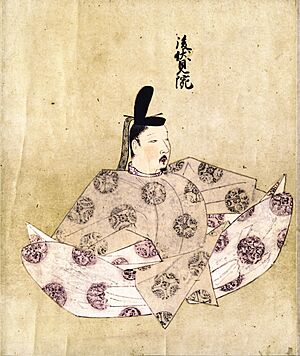Emperor Go-Fushimi facts for kids
Quick facts for kids Emperor Go-Fushimi後伏見天皇 |
|||||
|---|---|---|---|---|---|
 |
|||||
| Emperor of Japan | |||||
| Reign | 30 August 1298 – 2 March 1301 | ||||
| Coronation | 17 November 1298 | ||||
| Predecessor | Fushimi | ||||
| Successor | Go-Nijō | ||||
| Shōgun | Prince Hisaaki | ||||
| Born | 5 April 1288 | ||||
| Died | 17 May 1336 (aged 48) Jimyōin (持明院), Heian-kyō |
||||
| Burial | Fukakusa no kita no Misasagi (深草北陵) (Kyoto) | ||||
| Issue more... |
|
||||
|
|||||
| House | Yamato | ||||
| Father | Emperor Fushimi | ||||
| Mother | Itsutsuji (Fujiwara) Tsuneko | ||||
| Signature |  |
||||
Emperor Go-Fushimi (後伏見天皇 (Go-Fushimi-tennō)) was the 93rd emperor of Japan. He ruled from 1298 to 1301.
He was born on April 5, 1288, and passed away on May 17, 1336. His name, "Go-Fushimi," means "Later Emperor Fushimi." This is because he was named after his father, Emperor Fushimi. Sometimes, he is also called "Fushimi, the second."
Contents
Family Life
Before he became emperor, his personal name was Tanehito. He was the oldest son of Emperor Fushimi. His family belonged to a special branch of the Imperial Family called the Jimyōin-tō.
Go-Fushimi had many children. Some of them later became important figures in Japanese history:
- His main wife was Saionji Neishi, also known as Kōgimon'in.
- Their daughter was Imperial Princess Junshi.
- Their son, Imperial Prince Kazuhito, later became Emperor Kōgon.
- Another son, Imperial Prince Yutahito, later became Emperor Kōmyō.
These two sons, Emperor Kōgon and Emperor Kōmyō, played a big role in a later period of Japanese history.
Key Events in Go-Fushimi's Reign
Here are some important moments from Emperor Go-Fushimi's life:
- 1289: Tanehito was chosen to be the Crown Prince, meaning he would be the next emperor.
- August 30, 1298: His father, Emperor Fushimi, stepped down from the throne. Tanehito became the new emperor. This is called senso.
- November 17, 1298: Emperor Go-Fushimi officially took the throne in a ceremony called sokui. A new nengō (era name) called Shōan began.
- November 1, 1299: A Chinese Zen Buddhist master named Yishan Yining arrived in Japan. He was an envoy from the Mongol Empire.
- March 2, 1301: Emperor Go-Fushimi stepped down from the throne. This happened because another branch of the Imperial Family, the Daikakuji Line, gained more power.
- September 11, 1308: His younger brother became Emperor Hanazono. Go-Fushimi then became a "retired emperor."
- May 17, 1336: Emperor Go-Fushimi passed away.
After he stepped down, Go-Fushimi acted as a "cloistered emperor" for a few years, from 1313 to 1318. This meant he still had influence even though he wasn't officially on the throne.
During the reign of Emperor Hanazono, the Kamakura shogunate (the military government) tried to make a deal. They agreed that the throne would switch between the two Imperial Family lines (Go-Fushimi's line and the Daikakuji line) every 10 years. This agreement was called the Bumpō Agreement, but it didn't last long. Emperor Go-Daigo later broke it.
Emperor Go-Fushimi is known for writing a special prayer to the god of the Kamo Shrine. He asked for help so that his son could become emperor. His prayer eventually worked, but it took 33 years after Go-Fushimi stepped down for his son, Emperor Kōgon, to become emperor. Emperor Kōgon was the first emperor of the Northern Court, supported by the Ashikaga shogunate.
Emperor Go-Fushimi is buried with other emperors at an imperial tomb called Fukakusa no kita no misasagi (深草北陵) in Fushimi-ku, Kyoto.
Important Court Officials (Kugyō)
The Kugyō (error: {{nihongo}}: Japanese or romaji text required (help)) were a small group of very powerful men in the emperor's court. Even when the emperor didn't have much power outside the palace, these officials were still very important. They were usually from noble families and had a lot of experience.
During Go-Fushimi's time, some of the top Kugyō included:
- Sesshō (Regent): Takatsukasa Kanetada (1298) and Nijō Kanemoto (1298–1300)
- Kampaku (Chief Advisor): Nijō Kanemoto (1300–1305)
- Other high-ranking officials like Sadaijin, Udaijin, Nadaijin, and Dainagon.
Eras During Go-Fushimi's Rule
In Japan, years are also named after special eras called nengō. Here are the era names during Emperor Go-Fushimi's reign:
See also
 In Spanish: Go-Fushimi Tennō para niños
In Spanish: Go-Fushimi Tennō para niños
- Emperor of Japan
- List of Emperors of Japan
- Imperial cult

